AY-3-8500
The AY-3-8500 "Ball & Paddle" integrated circuit was the first in a series of ICs from General Instrument designed for the consumer video game market. These chips were designed to output video to an RF modulator, which would then display the game on a domestic television set. The AY-3-8500 contained six selectable games — tennis (a.k.a. Pong), soccer, squash, practice, and two rifle shooting games. The AY-3-8500 was the 625-line PAL version and the AY-3-8500-1 was the -line NTSC version. It was introduced in 1976, Coleco becoming the first customer having been introduced to the IC development by Ralph H. Baer.[1] A minimum number of external components were needed to build a complete system.
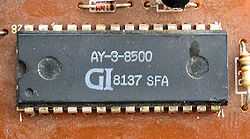
The AY-3-8500 was the first version. It played seven Pong variations. The video was in black-and-white, although it was possible to colorize the game by using an additional chip, such as the AY-3-8515.
Games
Six selectable games for one or two players were included:
| Game | Number of players |
|---|---|
| Tennis | 2 |
| Soccer | 2 |
| Squash | 2 |
| Practice | 1 |
| Rifle game 1 | 1 |
| Rifle game 2 | 2 |
In addition, a seventh undocumented game could be played when none of the previous six was selected: Handicap, a soccer variant where the player on the right has a third paddle. This game was implemented on very few systems.
Usage
The AY-3-8500 was designed to be powered by six 1.5 V cells (9 V). Its specified operation is at 6...7 V and a maximum of 12 V instead of the 5 V standard for logic. The nominal clock was 2.0 MHz, yielding a 500 ns pixel width. One way to generate such a clock is to divide a 14.31818 MHz 4×colorburst clock by 7, producing 2.04545 MHz. It featured independent video outputs for left player, right player, ball, and playground+counter, that were summed using resistors, allowing designers to use a different luminance for each one. It was housed in a standard 28-pin DIP.
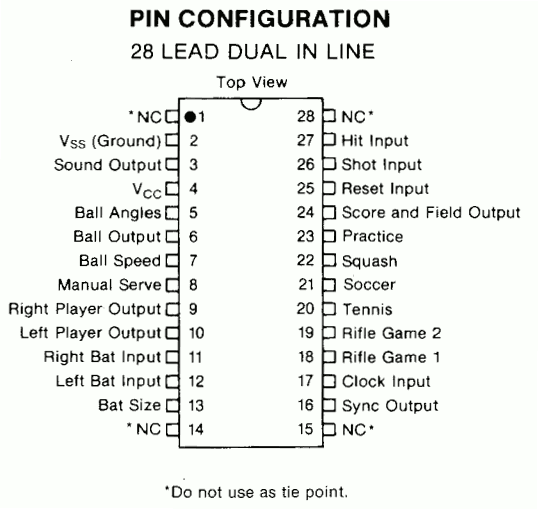
Applications
Some of the dedicated consoles employing the AY-3-8500 (there are at least two hundred different consoles using this chip[2]):
- Sears Hockey Pong
- Coleco Telstar (Telstar, Classic, Deluxe, Ranger, Alpha, Colormatic, Regent, Sportsman)
- Magnavox Odyssey (300, 2000 and 3000)
- Radio Shack TV ScoreBoard
- Unisonic Sportsman/Tournament
- Philips Tele-Spiel ES2203 and ES2204
- Zanussi/Seleco Play-O-Tronic
- Videomaster (Strika, Strika 2,ColourScore 2, SuperScore)
- APF TV Fun (Model 401)
- Sportsmaster TVG 901
AY-3-8550
The AY-3-8550 was the next chip released by General Instruments. It featured horizontal player motion, and a composite video output. It was pin compatible with the AY-3-8500. It needed an additional AY-3-8515 chip to output video in color.
Games
Six selectable games for one or two players were included:
| Game | Number of players |
|---|---|
| Tennis | 2 |
| Soccer | 2 |
| Squash | 2 |
| Practice | 1 |
| Rifle game 1 | 1 |
| Rifle game 2 | 2 |
Usage
The AY-3-8550 used the No Connect pins from the AY-3-8500, so it was possible to put an AY-3-8550 on an AY-3-8500 (without horizontal movement), and vice versa.
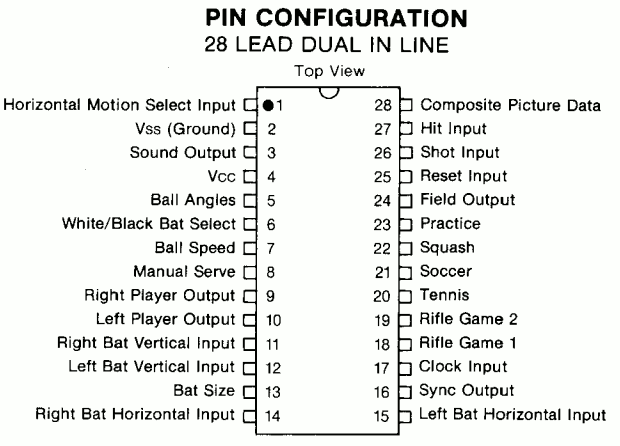
AY-3-8610
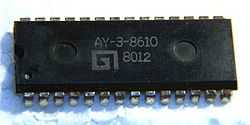
The AY-3-8610 was a major update from General Instruments. It played more games, like basketball or hockey, with more graphics quality. It was nicknamed "Superstar" by GI. It was in black and white, although it's possible to add colour by using an additional AY-3-8615 chip.
Games



The 10 selectable games for this chip included:
| Game | Number of players |
|---|---|
| Tennis | 2 |
| Hockey | 2 |
| Soccer | 2 |
| Squash | 2 |
| Practice | 1 |
| Gridball | 1 |
| Basketball | 2 |
| Basketball practice | 1 |
| Two player target | 2 |
| Single player target | 1 |
Usage
The AY-3-8610 featured a completely different pinout. It, too, required an external crystal oscillator. It still has separate video output pins, and the dedicated sync pin is now gone.

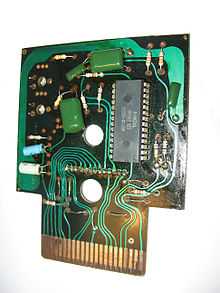
Derivatives
- An equivalent to the AY-3-8500 is the TMS1965NLA manufactured by Texas Instruments.
- The Soviet K145IK17 has built-in counter, making it possible to use momentary pushbutton instead of milti-position switch to select games. Handicap game is not hidden, it can be chosen among others using this button. Since pushbutton occupies only one pin, this IC has less pins.
- A successor to the AY-3-8500 is the AY-3-8510, manufactured by General Instrument, housed in a 16-pin DIP and released in 1978. It only has four games but they are in color. One of the few consoles that use the AY-3-8510 is the Coleco Telstar Colortron.
- A competitor was the National Semiconductor MM57105.
References
- ↑ http://www.pong-story.com/coleco.htm The Coleco Telstar story
- ↑ http://www.pong-story.com/mypongs.htm List of first era consoles